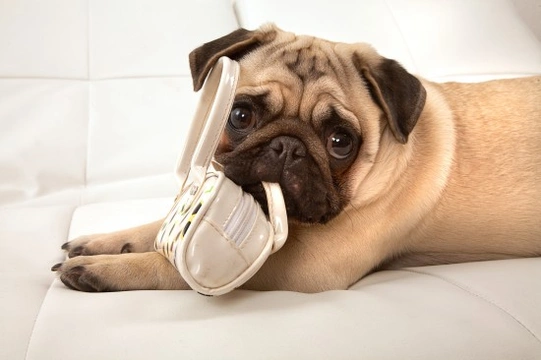
Leave it! Five simple steps to training your dog away from your possessions
It is a scenario that every dog owner has undoubtedly faced at some stage: The persistent canine that simply cannot or will not recognise what is “theirs” versus what is “yours,” and continually attempts to play with, chew or steal your own possessions. Whether it is your favourite slippers, the newspaper, children’s toys or even items of clothing or furniture, this annoying habit can be both destructive and inconvenient, as well as even potentially proving dangerous to your dog.
The usual reaction of “no!” or “leave it!” followed up by energetically pursuing the errant canine around the home and wrestling the prize from them might seem like the most obvious course of action to follow, particularly if the chances of damage to your property rise the longer you leave it; for instance, if your dog has taken your newspaper or something else that can easily become damaged by your dog. However, following this course of action, no matter how obvious it might seem at the time, can in fact cause more problems than it solves. If your dog gets an exaggerated reaction out of you when they take your things, even if that reaction is negative, you are in effect rewarding their behaviour with your response, something that can lead to an ongoing cycle of negative action by your dog and corresponding attention from yourself. This is particularly true if you then turn reclaiming your possessions into a chasing game, ended with a hearty bout of wrestling at the end!
So, how on earth can you reclaim your possessions from your errant dog effectively without storing up difficulty for later on down the line when the problem arises again? Read on to learn five simple steps to training your dog to leave your things alone when told!
1. Keep your cool
Step one of reclaiming what is rightfully yours is the key to the whole process: Keep your cool and don’t react instinctively by yelling and chasing after your dog. This can be difficult to achieve if your dog has taken something valuable or something that they will easily be able to destroy, but it is vital to get stage one down perfectly before you can continue through stages two through five. Getting your dog excited, wound up or stressed about things, even if they have been bad, will only escalate the situation, and may lead to them persistently looking for new things to steal and chew on or play with in order to find an outlet for their desire to chew and take ownership of things, or to ease their anxiety!
2. Make sure your dog knows they have done wrong
Don’t lunge for your dog or try to grab the item in question away from them, and don’t yell or smack your dog. Get your dog’s attention by using their name and movement to draw their eye, then give a command that they recognise (such as “no” or “leave it” or “drop it”). Reinforce this by placing a hand on your dog’s neck or rump to further divert them to look to you and follow your instruction, rather than focusing on the item they have made off with.
3. Divert your dog’s attention
Once your dog has surrendered the item in question, divert their attention away from it and what you are doing with it by offering them an alternative or reward, such as an appropriate toy that they particularly like, or a treat. If you haven’t managed to convince your dog to drop the item already following step two, this stage can also be used as a bargaining tool to convince your dog to hand over the thing that you want and receive something else instead.
Never offer your dog a “swap” and then take both the forbidden item and the offered swap away; this will cause your dog to reject your deal in future! Also, always ensure that your dog has dropped and given up the item that you want before you give them the alternative; do not accept your dog trying to keep both, or lunging for the original item when they already have the replacement in their posession!
4. Take ownership of the item in question
Taking ownership of the item that your dog has given up is important, and this means more than simply picking up the item and walking away with it. Make it clear to your dog through your body language and tone of voice that the item they took is yours, and not for sharing! This is an effective method of pack communication with your dog, and is how the pack leader (you, in this case!) will transmit to other dogs that they are not willing to share, in a language that your dog will easily understand.
5. Provide alternatives
Chewing things, burying toys and resource guarding are all natural canine behaviours, and if your dog has a particular propensity to undertake them you must allow an outlet for these needs in appropriate, healthy ways. Dogs also enjoy chewing things to relieve teething pain at the juvenile stage, and to ease stress and keep them occupied as adults.
Make sure that your dog has a suitable range of chews, toys and puzzles that they are allowed access to, in order to keep them on an even keel and divert them from taking your things instead!



